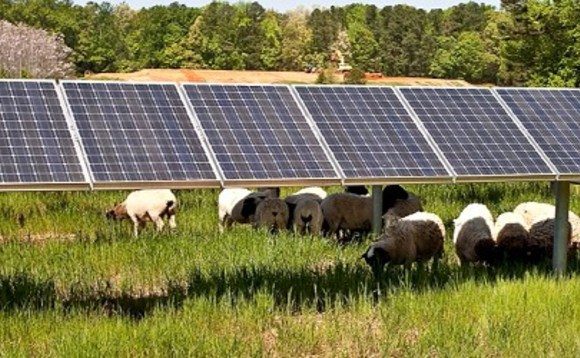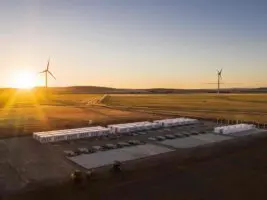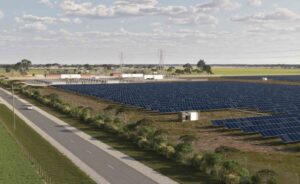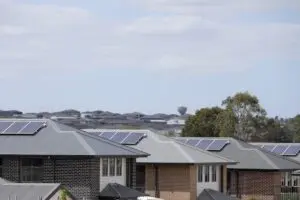Tasmania’s first solar farm will host “a couple of thousand” sheep and is a perfect solution for delicate pasture, says the landowner who is behind the $500 million Northern Midlands Solar Farm.
Roderic O’Connor, whose family has been on the land for some 200 years and who owns the farm and the 288 megawatt (MW) solar project, says they will use more rotational grazing under the panels which will allow them to manage grasses, particularly the native varieties, more efficiently.
The Connorville farm currently hosts around 22,000 sheep, and that won’t change. O’Connor says around 2,000 of these sheep will be rotated through the area that will host the solar project.
“The areas we’ve chosen for the solar farm is quite light country which needs careful grazing, so I’m delighted to be putting a solar farm there,” O’Connor told RenewEconomy.
The project is the second this week to prove that agrisolar can work, as the New England solar farm owner says it shares the land with 2000 merinos – soon to be 6,000 – and it contradicts the fear-mongering that valuable agricultural land is being lost to solar farms.
One query O’Connor has been fielding is whether sheep will get caught on the panels, which at their peak dip to around 40cm above the ground. He says this won’t happen because panels are designed with clean edges to catch the sun – not animals.
The Northern Midlands project is unusual, in that landowner O’Connor currently owns it entirely himself.
It means he’s tried to take significant care with community consultation, a factor that helped win unanimous approval from the local council on Monday evening.
“We were confident [of council unanimity], because this has been run by a landowner who lives in this community,” he says.
“We’ve tried to give as much information so there are no surprises, and we’ve tried to be fair and equitable in everything we do. For the council, the community, and our neighbours. Can we do more? Yes, and we will.”
O’Connor is now looking for equity partners who can fund the development, which will be undertaken by newly formed company TasRex.
The 543 hectare site on O’Connor’s farm, near the town of Cressy, will connect to the grid via a 220 kV double circuit overhead transmission line to the nearby Palmerston substation. It will be backed up by a 345.9 MW / 691.7 MWh battery.

Designed with agriculture-first mindset
O’Connor says the opportunity to put a renewable energy project on his property came by chance. A friend in Melbourne, Simon Reed from Robert Luxmoore, was scouting for land in Tasmania, so he pitched in to help.
It just so turned out that the perfect, free piece of agricultural land near Launceston and close to the local substation was his.
“The first thing I thought was why not? I can graze the area, it’s incredibly well hidden, it fits in with the infrastructure and our conservation covenants,” he says.
Pumped hydro and wind were both considered, but quickly dismissed. But neighbours were still sceptical of solar, asking why bother with such a project in Tasmania.
“What surprised me the most is that most asked why put a solar farm in Tasmania? We have as much usable daylight as parts of central Victoria, and more than Melbourne,” he says.
“And we’re in the [state] renewable energy zone.”
He had relatively little input into where the panels would go, trusting to his advisors and thinking that so long as he can graze around and under them, it didn’t matter too much about the final design outcome.
Long-term planning
Getting the solar farm off the ground has been a learning curve for O’Connor, who unusually for the farmer landowner involved in renewables, is the proponent of the project.
He is not a renewables developer and had to pull in help from the likes of Cogency in Melbourne to handle the community engagement and his friend Simon Reed.
The upfront costs and process of getting the project to development phase have been “daunting”.
But the long term possibilities are intriguing.
“The priority is either carbon projects or being able to grab some of the carbon credits, for the whole property,” he says.
O’Connor hopes a whole-of-property attitude towards sustainability may be the way of the future. In that future, being a renewables projects hosts would boost his property Connorville’s carbon sequestration capacity far beyond the norm for a sustainably-run farm.
He has an opportunity to invest in TasRex, the company launched in October that will develop the solar project, which is another benefit for the wider O’Connor family.
“The fourth thing is I want to set something up for our greater local community. Not sure what it is at the moment. So when you say ‘is the income important’, yes it is, but it’s to help my family in the future, to keep them all on the land, but also to further invest in the renewable energy and in my community.”










